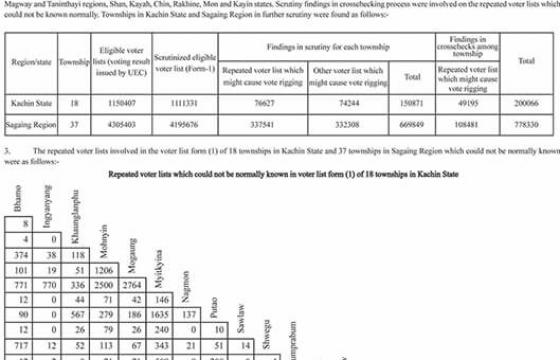Lately, the military bloc’s supporter, obviously made up of Union Solidarity Development Party (USDP) members, former and active soldiers in civil and sympathizers have staged demonstration to support the Military’s or Tatmadaw’s “war of justice” or “just war” in Rangoon (Yangon), Moulmein (Mawlamyaing) and recently in Mandalay. Similar events would also take place in other cities according to the news sources.
The demonstration or rally in Mandalay, on January 15, was said to be attended by some two thousand people marching from Mandalathiri football stadium to Manawyaman park, where speeches were delivered and letters of support for the justified war occasion were read out, sent from some small nationalist parties, which some of them also attended.
Although the last two rallies that supported the military offensives against the Ethnic Armed Organizations (EAOs) in Shan and Kachin States, which claimed to be a justified war, were peaceful, the recent one in Mandalay has not been the case.
An anti-war motorcyclist Ko Thae Nit Aung bearing an anti-war vinyl banner, at the back of the seat, passing through the demonstration crowd was manhandled and the Irrawaddy’s photographer Zaw Zaw was also attacked for photographing the assault on the lone protester.
The incidents might be small ones, but if this could lead to the political division among the mass, like protest and counter-protest of the red and yellow shirt major groupings that had paralyzed Thailand, leading to the military coup. Similarly, Burma might have added another facet of ideological mass conflict of pro-war and anti-war, apart from the ethnic and communal conflicts, which wouldn’t benefit the ongoing peace negotiation process and national reconciliation effort in any way.
Let us have a close look at this war of justice rhetoric and how it could affect or influence the political climate.
Anti-war rallies
Massive anti-war rallies held in Kachin State of Myitkyina last year October and a peace rally held also last year July, in Rangoon were aimed at pressuring the government to stop the wars in ethnic States of Kachin and Shan, which are still ongoing without any sign of let up.
The Tatmadaw offensives on Kachin Independence Army (KIA) positions, notably along the Burma-China border where the Kachin headquarters Laiza is located, started in earnest on the heels of the State Counselor Aung San Suu Kyi initiated 21st Century Panglong Conference (21CPC) of August 31 to September 3, last year.
After enduring some three months of the Tatmadaw military onslaught, the KIA thought out a strategy to take the heat away from its besieged forces in Kachin State, decided to launch a counter-offensive in Muse Township of northern Shan State together with the Kokang or Myanmar National Democratic Alliance Army (MNDAA), Ta’ang National Liberation Army (TNLA) and Arakan Army (AA), calling itself Northern Alliance – Burma (NA-B), on November 20 last year.
Consequently, the Tatmadaw heightened its attacks on the KIA positions in Kachin State and to date has overrun seven bases in total, including two strategic mountain outposts – Lai Hpawng and Gideon, using airstrikes, heavy artillery bombardment and massive infantry deployment at a tremendously high human toll and financial cost.
But the collateral damage resulting from the armed engagements in Kachin and Shan States were squarely placed on the shoulders of the NA-B by the Military, to justify its policy of total annihilation and escalation of the armed confrontation, under the banner of a just war.
Just war
Accordingly, the supporters of military offensives echoed the line of Tatmadaw tagging the NA-B members as terrorist organizations that have to be eliminated, as they are infringing on national sovereignty and disrupting, destroying individual and public properties, aside from levying taxed or protection money, as the Tatmadaw is inclined to term, on the population, among others.
This sentiment or reasoning, repeatedly used to attack the EAOs by the Tatmadaw, was aired and reiterated by Hla Swe of USDP, a former parliamentarian MP during President Thein Sein government, who was also one of the leading participants and an orator during the Mandalay’s just war demonstration recently, on January 15.
Prior to this, in a BBC Burmese discussion program of “Global and Burma Affairs” on January 13, where Hla Swe, Khun Ja of Kachin Peace Network, and ethnic affairs observer and analyst Maung Maung Soe participated, Hla Swe gleefully said: “In Sri Lanka the Tamil Tigers that had stood on the three point position of no ceasefire, no negotiation and fight for independence were totally eliminated (by the government troops) and there is no one left now. I see that if the golden opportunity invitation now is taken (by the EAOs) they will be better off.”
During the discussion earlier, when asked what should be done to be all-inclusive in the peace process, he replied: “It depends on the leaders. If the 21st Century Panglong Conference is called and there is no (positive) result, the EAOs could be crushed.”
The Commander-in-Chief has time and again also made known publicly the Tatmadaw’s stance of surrender for the excluded three EAOs – MNDAA, TNLA and AA – and pressuring the KIA, which is also head of the United Nationalities Federal Council (UNFC) to sign the Nationwide Ceasefire Agreement (NCA) without alteration, so that they will be allowed participation in the 21CPC or Union Peace Conference (UPC).
Criteria of a just war
The brief and summarized explanation of the just war theory is written by Richard N. Haas, President, Council on Foreign Relations, in his short piece “When is War Justifiable?”, in May 5, 2009, as follows:
- Just war theory today is a composite that has evolved from ideas developed by various religious figures. In the 5th century, St. Augustine discussed in City of God the circumstances under which killing could be justified and empires legitimately expanded. In the 13th century, St. Thomas Aquinas laid out a more elaborate just war doctrine in his Summa Theologica. He wrote that three conditions were necessary to make a war just: it must be ordered by a competent authority; the cause must be just; and the combatants must have “a right intention, so that they intend the advancement of good, or the avoidance of evil.”
- Modern just war guidance involves both the decision to go to war (jus ad bellum) and how to fight one (jus in bello). This latter set of criteria focuses on proportionality (how much force is used), targeting (avoiding non-combatants), and means (avoiding certain classes of weapons).
Assessment of the Military’s just war rhetoric
If we look at the recent conflict situation between the Tatmadaw and the EAOs, the decision to go to war from the part of the former is hardly appropriate and convincing, seen from the given set of just war criteria.
Firstly, it was not ordered by the competent authority as the Tatmadaw is not the government, but pursuing its own policy and implementing it, within the mode of “a state within the state”. While the NLD civilian government is tight-lipped on the Tatmadaw’s offensives on the EAOs, for whatever reason it might have in store, it has never officially declared war or spelled out that it supported the Tatmadaw’s actions. In contrast, the NLD official position is all-inclusiveness participation of all the EAOs and ending the war through peaceful negotiation, while the Tatmadaw is for the exclusion of the three EAOs – MNDAA, TNLA and AA – that it dislike and using military means to force the remaining EAOs that are yet to sign the NCA give in to its prescribed conditions.
Thus, the Tatmadaw is in no way a competent authority to wage or order a just war.
Secondly, the question of whether the cause is just from the point of the Tatmadaw going to war against the EAOs, it is quite clear that is not the case.
Most of the EAOs went into rebellion, during the late 1950s and early 1960s, to wrestle back their rights of self-determination, which were hijacked or stolen from them by the successive military and also Bamar-dominated civilian governments and treated them as if they were colonial possessions.
In trying to right this wrong the EAOs are now ready and set to negotiate through political means peacefully, as the military solution is not tenable, and are just waiting for the agreement of the Tatmadaw to accept all-inclusiveness participation that have been denied to some, coupled with waging war on them.
Thus, this war cannot be a just war, as there are many peaceful solution available and the Tatmadaw is choosing war, to gain political edge and not interested in a fair deal to end the conflict.
Thirdly, the question of whether the Tatmadaw has “a right intention, so that they intend the advancement of good, or the avoidance of evil,” one has to say it doesn’t cater to any of the mentioned reasonable intention.
The Tatmadaw intention is to lord over the ethnic nationalities without consideration of agreeing to their aspirations of equality, rights of self-determination, democracy and establishment of a genuine federal union.
Thus, the war is waged with ill intention of subjugating the ethnic nationalities and just to continue the rule over them.
Fourthly, on the questions of proportionality (how much force is used), targeting (avoiding non-combatants), and means (avoiding certain classes of weapons), indications are also not positive.
The proportionality of arsenal used are lopsided, as the Tatmadaw is employing advanced military aircraft and heavy artillery against lightly armed EAOs, begging the question of whether it is internationally acceptable to use jet fighters and helicopter gunships in a civil war.
Avoiding to target non-combatants is simply not the strong point of the Tatmadaw, as it sees the ethnic population hostile to its occupation troops and is convinced that most are sympathetic to the ethnic resistance armies. The Tatmadaw has indoctrinated its troops to treat the ethnic peoples along this line. Thus, the many extra-judicial killings, aerial and heavy artillery bombardments on ethnic settlement causing damage to properties and human lives have become the order of the day for the Tatmadaw in its occupation of the ethnic states.
The human rights violations on ethnic population is nothing new to the Tatmadaw, in its war of occupation that has been going on for decades and it is not about to be enlightened and become civil, in the sense of taking orders from the civilian government and turned into the protector of democratic principles.
The decades-long human rights abuses are well documented by reputed international rights organizations. But the toning down of the United Nations and European Union on human rights’ score, so as to encourage the Tatmadaw to endorse democratization is just a wishful-thinking and only embolden the Tatmadaw as the license to commit gross human rights violations.
Some of the recent following episodes would shed real light on the outcome of this misleading concept.
- Three civilians were killed and seven injured, including two women and a five-year-old child, when two Burma Army jets indiscriminately bombed Pang Mark Mur village, Kyaukme township, northern Shan State, on December 26, 2016. (Shan Human Rights Foundation – January 16, 2017)
- Two people were killed and eight were wounded when an artillery shell landed on a civilian house in Namhsan Township, Shan State on January 12 morning, according to local sources. One of the dead was an eight-year-old student who lived in the house, and the other was a dance instructor who had traveled from Mandalay to teach. The two deceased victims were killed instantly, according to Namhsan Township lawmaker Mai Win Htoo. (The Irrawaddy – January 13, 2017)
- Air strikes destroyed the buildings of civilians in the Mong Koe town and four civilians were killed in the clashes. According to official reports, the number of civilians injured so far has reached 63. At least 5000 have been displaced by the fighting, including more than 3600 who, Chinese state media has said, fled over the border. (Myanmar Times – December 6, 2016)
- Some 80 civilian hostages were taken by the Tatmadaw, during the NA-B siege of Mong Koe in November last year, which were said to be used as human shields to protect its outpost, according to the NA-B sources. They were later rescued by the NA-B. (NA-B Facebook)
- A battalion of Tatmadaw soldiers, who arrived in Mong Yaw sub-township on June 25 looking for Shan rebel troops, shot dead five villagers during an interrogation near a cornfield where some of them were working and dumped their bodies in shallow graves. (Radio Free Asia – July 21, 2016)
All in all, the call for supporting the just war rings hollow, as it is design to advance the program of the ethnocentric Military and Bamar political class, continued political monopoly, no justification could be found and the act would only be like pouring more oil in the already burning flames of animosity and hatred.
The people that support this just war rhetoric would be well advised to refrain from endorsing it further, so that not to become the culprit of creating another pro-war and anti-war ideological conflict that would split the mass into two, further driving the country into destruction and abyss.






